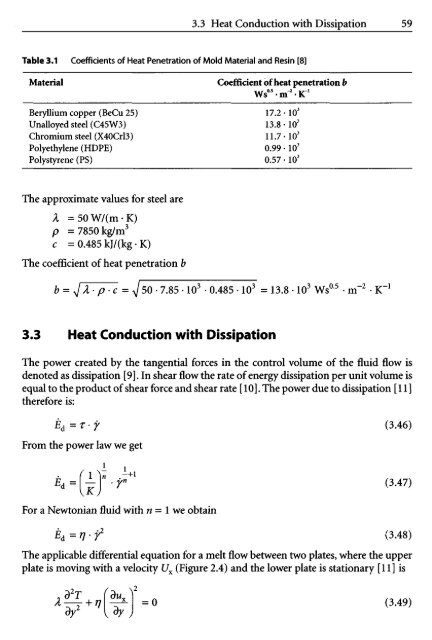HANSER Hanser Publishers, Munich • Hanser Gardner Publications ...
HANSER Hanser Publishers, Munich • Hanser Gardner Publications ...
HANSER Hanser Publishers, Munich • Hanser Gardner Publications ...
You also want an ePaper? Increase the reach of your titles
YUMPU automatically turns print PDFs into web optimized ePapers that Google loves.
Table 3.1 Coefficients of Heat Penetration of Mold Material and Resin [8]<br />
Material<br />
Beryllium copper (BeCu 25)<br />
Unalloyed steel (C45W3)<br />
Chromium steel (X40Crl3)<br />
Polyethylene (HDPE)<br />
Polystyrene (PS)<br />
The approximate values for steel are<br />
A =50W/(m-K)<br />
p =7850kg/m 3<br />
c = 0.485 kj/(kg <strong>•</strong> K)<br />
The coefficient of heat penetration b<br />
3.3 Heat Conduction with Dissipation<br />
The power created by the tangential forces in the control volume of the fluid flow is<br />
denoted as dissipation [9]. In shear flow the rate of energy dissipation per unit volume is<br />
equal to the product of shear force and shear rate [ 10]. The power due to dissipation [11]<br />
therefore is:<br />
From the power law we get<br />
For a Newtonian fluid with n - 1 we obtain<br />
Coefficient of heat penetration b<br />
Ws 05 Hi 2 KT 1<br />
17.2 <strong>•</strong> 10 3<br />
13.8 <strong>•</strong> 10 3<br />
11.7- 10 3<br />
0.99 <strong>•</strong> 10 3<br />
0.57 <strong>•</strong> 10 3<br />
(3.46)<br />
(3.47)<br />
(3.48)<br />
The applicable differential equation for a melt flow between two plates, where the upper<br />
plate is moving with a velocity Ux (Figure 2.4) and the lower plate is stationary [11] is<br />
(3.49)
















